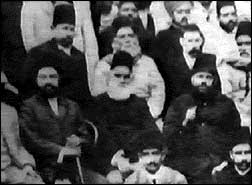Lucknow Pact, 1916
The Lucknow pact was the product of Hindu-Muslim unity envisaged by M. A. Jinnah. In December 1915, the ML and Congress met separately in Bombay. Both the parties set up committees for making a scheme for constitutional changes in consultation with other political parties.
Role of the Quaid-e-Azam
Jinnah did a lot to unite the two nations along with the recognition of the rights of Muslims. Meeting of both parties held at Lucknow in 1916. The constitutional proposals were approved:
1. One Third seats for Muslims in the Imperial Legislative Council.
2. Separate Electorate
3. Half members of the Executive Council to be elected by the Imperial Legislative Council.
4. Commissioned ranks of the army for Indians.
5. Expansion of Provincial Legislative Councils.
6. Half members of the Governorís Executive Council be elected by Provincial Legislative Council
7. Weightage to minorities in provinces.

Muslim League leaders pose for a group photo at Lucknow, 1916
Gains from Muslim Point-of-view
1. Separate Electorate
2. One Third Muslim seats in Central Legislature.
3. Unofficial bill, if opposed by three-fourth members of a community, it will not be passed.
August 20, 1917 Announcement by British Government
Secretary of State Montagu promised for:
1. Greater association of Indian in all branches of government.
2. Responsible government
3. Induction of Indians in the commissioned ranks.
Previous
TOC
Next